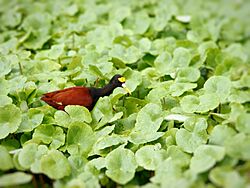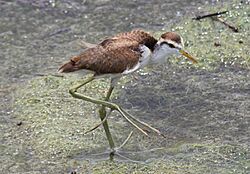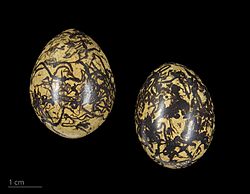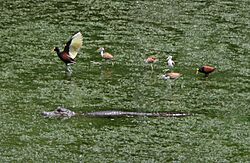Northern jacana facts for kids
Quick facts for kids Northern jacana |
|
|---|---|
 |
|
| In Tortuguero National Park, Costa Rica | |
| Conservation status | |
| Scientific classification | |
| Genus: |
Jacana
|
| Species: |
spinosa
|
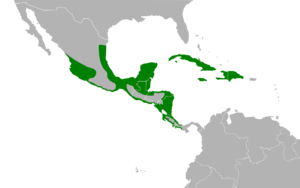 |
|
| Synonyms | |
|
Fulica spinosa Linnaeus, 1758 |
|
The northern jacana (Jacana spinosa) is a unique wetland bird. It lives in coastal areas from Mexico down to western Panama. You can also find it on islands like Cuba, Jamaica, and Hispaniola in the Caribbean. Sometimes, it even breeds in Texas, United States. It has also been seen in Arizona.
Jacanas are known for their huge feet and long claws. These special feet help them walk on floating plants. They live in shallow lakes, which are their favorite homes. In Jamaica, this bird is sometimes called the 'Jesus bird'. This is because it looks like it's walking on water!
Contents
What Does the Northern Jacana Look Like?
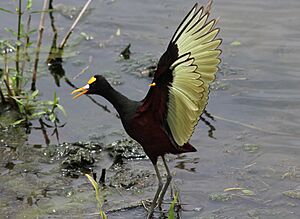
The northern jacana has a dark brown body. Its head and neck are black. It has a yellow patch on its bill and a yellow wattle on its forehead. The base of its bill is white.
When a jacana flies, you can see its yellowish-green wing feathers. These feathers get their color from a rare pigment called zooprasinin. You can also see yellow bony spurs on the front edge of its wings. The jacana uses these spurs to defend itself and its young.
Size and Young Birds
Female jacanas are about twice as big as males. Females weigh around 145 grams (5 ounces). Males weigh about 87 grams (3 ounces). Jacanas are usually about 24 centimeters (8 inches) long. Their wingspan is around 51 centimeters (20 inches).
Young jacana chicks are covered in soft down feathers. They have patterns of orange, brown, black, and some white. Older chicks are gray with brownish upper parts.
Where Do Northern Jacanas Live?
The northern jacana lives from Mexico all the way to Panama. They sometimes visit the southern United States. You might even see them in places like Arizona.
These birds mainly live in coastal areas. Jacanas make their homes on floating plants. They prefer swamps, marshes, and ponds.
How Do Northern Jacanas Behave?
What Do Northern Jacanas Eat?
Northern jacanas mostly eat insects found on the surface of plants. They also eat parts of water lilies. Their diet includes snails, worms, small crabs, fish, mollusks, and seeds. Jacanas sometimes compete for food with other birds, like the sora.
Northern Jacana Life Cycle and Reproduction
The northern jacana has a very interesting family life. It is unusual among birds because one female mates with several males. This is called a polyandrous society. A female jacana has a territory that includes the territories of one to four males.
The female and her males stay together all year, even when they are not breeding. These relationships last until a male or female is replaced. The female keeps her bonds with her mates by laying eggs for them. She also protects their territories and defends the eggs from predators.
Nest Building and Eggs
The male jacana builds a floating nest. He uses whatever plant material he can find. He pulls up plants and drops them in the nest. Then, he pushes and steps on the plants to make a strong, compact nest. The best nests are dense and stable. A male might build several nests. The female then chooses one, or she might find her own spot in the territory.
This bird lays a clutch of four brown eggs with black marks. These eggs are usually about 30 by 23 millimeters (1.2 by 0.9 inches). The male sits on the eggs to keep them warm for 28 days. This is called incubation. A female might sometimes shade the eggs, but she rarely incubates them.
Males spend most of their time near the nest during incubation. However, they sometimes leave the nest alone for a while. When each egg hatches, the male stands next to the nest to look inside. He continues to incubate the remaining eggs while caring for the hatched chicks. Once all the eggs have hatched, the male removes the empty eggshells. He then leads the chicks away from the nest within 24 hours.
Caring for Chicks
Chicks can swim, dive, and find food soon after they hatch. The male does not feed the chicks directly. Instead, he leads them to food. The male will keep the chicks warm under his wing for many weeks. As the chicks grow, fewer can fit under his wing. Females might also care for chicks when the male is away.
Both males and females protect their territory more strongly when chicks are born. Males do not like other birds in their territory. They call the female for help to defend against predators. Females respond to every call the male makes. They care a lot about the safety of the chicks, even though they don't interact with them much. The females provide the males with a new clutch of eggs when the chicks are 12 to 16 weeks old.
Who Hunts the Jacana?
Predators of the jacana include snakes, caimans, snapping turtles, and various large birds and mammals.
How Do Jacanas Communicate?
Jacanas usually make calls to each other when they are mating pairs. Fathers also call to their young. Jacanas make "clustered-note calls" when they attack other birds in their territories. They also make calls when eggs or chicks are in danger from predators. The type of call depends on how urgent the threat is. Calls are also made during flight. A female might call if she is away from the territory for too long. A male might call if he cannot find a chick.
What is the Northern Jacana's Status?
Northern jacanas seem to be common in most places they live. However, they could become vulnerable if their wetland homes are lost.



